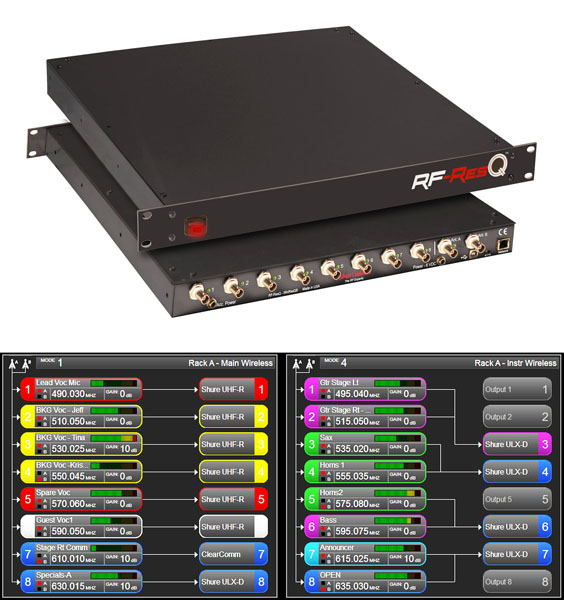
Spectrum At Higher Frequencies
Since the UHF band is the target of much of the spectrum repurposing, wireless designers are also developing systems that operate in the 2.4 GHz (WiFi), 1.9 GHz (DECT), and 900 MHz (ISM) bands.
Though these limited spectra can be crowded with other applications, the new designs are able to offer a handful to perhaps a dozen simultaneous channels with excellent audio quality – enough channels to fully cover many requirements or to supplement a more complex production.
Unlike many of the UHF-band systems, the 2.4 GHz systems are more likely to offer channel designations rather than direct access to particular frequencies within the receiver’s bandwidth, such as setting a transmitter to 2.4385 GHz. These systems instead will display a set of pre-selected channels transmitting on the underlying coordinated frequencies, allowing the user to set transmitter/receiver pairs to channels 1 – 14, for example.
Other systems use frequency hopping or similar technologies, where the same channel number on a transmitter/receiver pair may use different frequencies each time the system is used while also calculating and holding backup frequencies that can be instantaneously changed at both the receiver and transmitter if RF conditions change.
Remote Antennas & Receivers
Attention has also been directed toward placing antennas closer to the performing area where the transmitters are in use. And at least one manufacturer has the ability to remove their modular receivers from the chassis bays and remotely mount them (with antennas attached), running a Cat-5/6 cable between these small receiver modules and the receiver chassis. Such actions can help support the use of lower powered transmitters.
Some of the available antenna systems are active, boosting the received signal level before it travels to the receiver via coax cable. Directional antennas accomplish double duty, with increased sensitivity aimed toward the desired signals and lower sensitivity at the rear to attenuate interfering RF signals within their null zones. These specialized antennas may be offered by third-party vendors, who create various tools to make a wireless installation successful though they don’t manufacture wireless mics.
Third-Party RF Tools
Companies such as Kaltman Creations and RF Venue are another growing resource for wireless professionals, offering tools that can ease more complex wireless applications.
Both companies offer CP (circular polarization) antennas that help reduce interference and dropouts by more effectively picking up a transmitter signal in phase even as it moves through the performing area – along with other specialized antennas and antenna distribution systems.
RF Venue provides a rack-mountable spectrum analyzer combined with frequency coordination software, and an optical fiber RF distribution system. Kaltman Creations offers professional spectrum analysis and wireless coordination/monitoring tools for computers and tablets, along with handheld and multi-transmitter frequency counters within its Invisible Waves line. Kaltman also just introduced RF-ResQ, a distribution system with adaptive filtering to “clean up” the RF environment as seen by connected wireless receivers.
More Channels, Less Spectrum
Though in the years ahead we’ll certainly be dealing with placing more channels of wireless into shrinking spectrum resources, these leading manufacturers are working to stay ahead of the curve. The new wireless offerings are more powerful and flexible than ever before.
Enjoy our Real World Gear Photo Gallery Tour of the latest wireless microphone systems on the market.
Gary Parks is a pro audio writer who has worked in the industry for more than 25 years, holding marketing and management positions with several leading manufacturers.

